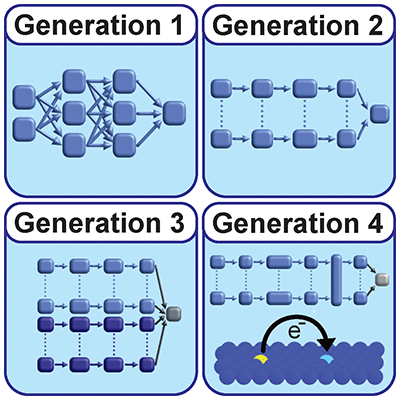当前位置:
X-MOL 学术
›
Chem. Rev.
›
论文详情
Our official English website, www.x-mol.net, welcomes your feedback! (Note: you will need to create a separate account there.)
Four Generations of High-Dimensional Neural Network Potentials
Chemical Reviews ( IF 51.4 ) Pub Date : 2021-03-29 , DOI: 10.1021/acs.chemrev.0c00868 Jörg Behler 1
Chemical Reviews ( IF 51.4 ) Pub Date : 2021-03-29 , DOI: 10.1021/acs.chemrev.0c00868 Jörg Behler 1
Affiliation

|
Since their introduction about 25 years ago, machine learning (ML) potentials have become an important tool in the field of atomistic simulations. After the initial decade, in which neural networks were successfully used to construct potentials for rather small molecular systems, the development of high-dimensional neural network potentials (HDNNPs) in 2007 opened the way for the application of ML potentials in simulations of large systems containing thousands of atoms. To date, many other types of ML potentials have been proposed continuously increasing the range of problems that can be studied. In this review, the methodology of the family of HDNNPs including new recent developments will be discussed using a classification scheme into four generations of potentials, which is also applicable to many other types of ML potentials. The first generation is formed by early neural network potentials designed for low-dimensional systems. High-dimensional neural network potentials established the second generation and are based on three key steps: first, the expression of the total energy as a sum of environment-dependent atomic energy contributions; second, the description of the atomic environments by atom-centered symmetry functions as descriptors fulfilling the requirements of rotational, translational, and permutation invariance; and third, the iterative construction of the reference electronic structure data sets by active learning. In third-generation HDNNPs, in addition, long-range interactions are included employing environment-dependent partial charges expressed by atomic neural networks. In fourth-generation HDNNPs, which are just emerging, in addition, nonlocal phenomena such as long-range charge transfer can be included. The applicability and remaining limitations of HDNNPs are discussed along with an outlook at possible future developments.
中文翻译:

四代高维神经网络电位
自大约 25 年前引入以来,机器学习 (ML) 势已成为原子模拟领域的重要工具。在最初的十年中,神经网络成功地用于构建相当小的分子系统的电位,2007 年高维神经网络电位 (HDNNP) 的发展为将 ML 电位应用于大型系统的模拟开辟了道路。数以千计的原子。迄今为止,已经提出了许多其他类型的 ML 势,不断增加可以研究的问题范围。在这篇综述中,HDNNPs 家族的方法论包括最近的新发展将使用分类方案讨论成四代电位,这也适用于许多其他类型的 ML 电位。第一代是由为低维系统设计的早期神经网络势能形成的。建立第二代的高维神经网络势能基于三个关键步骤:首先,将总能量表示为与环境相关的原子能量贡献的总和;其次,通过以原子为中心的对称函数作为满足旋转、平移和置换不变性要求的描述符来描述原子环境;第三,通过主动学习迭代构建参考电子结构数据集。此外,在第三代 HDNNP 中,还包括使用原子神经网络表示的环境相关部分电荷的长程相互作用。此外,在刚刚出现的第四代 HDNNP 中,可以包括非局部现象,例如远距离电荷转移。讨论了 HDNNP 的适用性和剩余限制以及对未来可能发展的展望。
更新日期:2021-03-29
中文翻译:

四代高维神经网络电位
自大约 25 年前引入以来,机器学习 (ML) 势已成为原子模拟领域的重要工具。在最初的十年中,神经网络成功地用于构建相当小的分子系统的电位,2007 年高维神经网络电位 (HDNNP) 的发展为将 ML 电位应用于大型系统的模拟开辟了道路。数以千计的原子。迄今为止,已经提出了许多其他类型的 ML 势,不断增加可以研究的问题范围。在这篇综述中,HDNNPs 家族的方法论包括最近的新发展将使用分类方案讨论成四代电位,这也适用于许多其他类型的 ML 电位。第一代是由为低维系统设计的早期神经网络势能形成的。建立第二代的高维神经网络势能基于三个关键步骤:首先,将总能量表示为与环境相关的原子能量贡献的总和;其次,通过以原子为中心的对称函数作为满足旋转、平移和置换不变性要求的描述符来描述原子环境;第三,通过主动学习迭代构建参考电子结构数据集。此外,在第三代 HDNNP 中,还包括使用原子神经网络表示的环境相关部分电荷的长程相互作用。此外,在刚刚出现的第四代 HDNNP 中,可以包括非局部现象,例如远距离电荷转移。讨论了 HDNNP 的适用性和剩余限制以及对未来可能发展的展望。






































 京公网安备 11010802027423号
京公网安备 11010802027423号